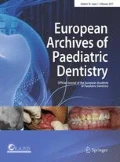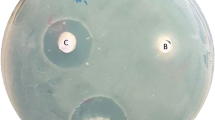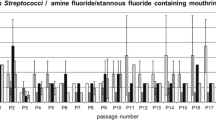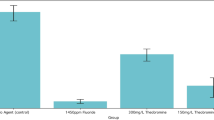Abstract
Aim
As suppression of Streptococcus mutans in young children may prevent or delay colonisation of the oral cavity, toothbrushing with dentifrices containing anti-S. mutans activity may aid in preventing caries. The aims of this study were to compare the effects of children’s dentifrices on the growth of S. mutans and non-mutans bacteria (Streptococcus sanguinis and Lactobacillus acidophilus).
Materials and methods
The agar diffusion assay at neutral pH was used to examine the antibacterial activity of commercial dentifrices and their major constituents.
Results
Dentifrices containing 1,450 ppm fluoride produced greater growth inhibition of both S. mutans and S. sanguinis than those with <500 ppm. No inhibition was seen for pure solutions of sodium fluoride or sodium monofluorophosphate at fluoride concentrations up to 100,000 ppm. Stannous fluoride exerted antibacterial effects at concentrations above 10,000 ppm. Significant growth inhibition of both S. mutans and S. sanguinis was seen with sodium lauryl sulphate at 2,500 ppm and with triclosan at 100 ppm. No inhibitory effects were seen for xylitol, sorbitol, sodium pyrophosphate or polyethylene glycol at concentrations up to 80,000 ppm.
Conclusion
Sodium lauryl sulphate is the major bacterial inhibitory compound in children’s dentifrices.

Similar content being viewed by others
References
Attramadal A, Svatun B. In vivo antibacterial effect of tin on the oral microflora. Scand J Dent Res. 1984;92:161–4.
Australian Research Centre for Population Oral Health. Recommendations for home use of fluoride. 2008. http://www.adelaide.edu.au/arcpoh/dperu/fluoride/Prac_info_Fl_Home_use.pdf. Accessed 9 Sept 2014.
Banas JA, Vickerman MM. Glucan-binding proteins of the oral streptococci. Crit Rev Oral Biol Med. 2003;14:89–99.
Blinkhorn A, Bartold PM, Cullinan MP, et al. Is there a role for triclosan/copolymer toothpaste in the management of periodontal disease? Br Dent J. 2009;207:117–25.
Block SS. Disinfection, sterilization and preservation. In: Use of metals as microbicides in preventing infections in healthcare. Philadelphia: Lippincott, Williams and Wilkins; 2001.
Buzalaf MAR. Fluoride and the oral environment. Monogr Oral Sci. Basel: Karger; 2011. vol. 22.
Chen F, Rice KC, Liu XM, et al. Triclosan-loaded tooth-binding micelles for prevention and treatment of dental biofilm. Pharm Res. 2010;27:2356–64.
Chikte UM, Rudolph MJ, Reinach SG. Anti-calculus effects of dentifrice containing pyrophosphate compared with control. Clin Prev Dent. 1992;14:29–33.
Ferretti GA, Tanzer JM, Tinanoff N. The effect of fluoride and stannous ions on streptococcus mutans. Viability, growth, acid, glucan production, and adherence. Caries Res. 1982;16:298–307.
Gunsolley JC. A meta-analysis of six-month studies of antiplaque and antigingivitis agents. J Am Dent Assoc. 2006;137:1649–57.
Hamada S, Torii M, Tsuchitani Y, Kotani S. Isolation and immunobiological classification of Streptococcus sanguis from human tooth surfaces. J Clin Microbiol. 1980;12:243–9.
Holder IA. In-vitro susceptibility of organisms isolated from burns to topical co-trimoxazole. J Antimicrob Chemother. 1981;7:623–7.
Kawabata S, Torii M, Minami T, Fujiwara T, Hamada S. Effects of selected surfactants on purified glycosyltransferases from mutans streptococci and cellular adherence to smooth surfaces. J Med Microbiol. 1993;38:54–60.
Koo H. Strategies to enhance the biological effects of fluoride on dental biofilms. Adv Dent Res. 2008;20:17–21.
Law V, Seow WK. A longitudinal controlled study of factors associated with mutans streptococci infection and caries lesion initiation in children 21 to 72 months old. Pediatr Dent. 2006;28:58–65.
Lynch RJM, Navada R, Walia R. Low-levels of fluoride in plaque and saliva and their effects on the demineralisation and remineralisation of enamel; role of fluoride toothpastes. Int Dent J. 2004;54:304–9.
Makinen KK. Sugar alcohol sweeteners as alternatives to sugar with special consideration of xylitol. Med Princ Pract. 2011;20:303–20.
Marinho VC, Higgins JP, Logan S, Sheiham A. Topical fluoride (toothpastes, mouthrinses, gels or varnishes) for preventing dental caries in children and adolescents. Cochrane Database Syst Rev. 2003:CD002782.
Marquis RE. Antimicrobial actions of fluoride for oral bacteria. Can J Microbiol. 1995;41:955–64.
Marquis RE, Clock SA, Mota-Meira M. Fluoride and organic weak acids as modulators of microbial physiology. FEMS Microbiol Rev. 2003;26:493–510.
Mayhew RR, Brown LR. Comparative effect of SnF2, NaF, and SnCl2 on the growth of Streptococcus mutans. J Dent Res. 1981;60:1809–14.
Mueller JR, Hinton JW. A protein-free medium for primary isolation of Gonococcus and Meningococcus. Proc Soc Exp Biol Med. 1941;48:330–3.
Murray PR, Zeitinger JR. Evaluation of Mueller–Hinton agar for disk diffusion susceptibility tests. J Clin Microbiol. 1983;18:1269–71.
Nathan P, Law E, Murphy D. A laboratory method for selection of topical antimicrobial agents to treat infected burn wounds. Burns. 1978;4:177–87.
Olsson J, Carlen A, Holmberg K. Inhibition of Streptococcus mutans adherence to hydroxyapatite with combinations of alkyl phosphates and nonionic surfactants. Caries Res. 1991;25:51–7.
Petersen FC, Assev S, Scheie AA. Combined effects of NaF and sls on acid- and polysaccharide-formation of biofilm and planktonic cells. Arch Oral Biol. 2006;51:665–71.
Plonka KA, Pukallus ML, Barnett AG, et al. A longitudinal case-control study of caries development from birth to 36 months. Caries Res. 2013;47:117–27.
Rogosa M, Mitchell JA, Wiseman RF. A selective medium for the isolation and enumeration of oral lactobacilli. J Dent Res. 1951;30:682–9.
Rykke M, Rolla G, Sonju T. Effect of sodium lauryl sulfate on protein adsorption to hydroxyapatite in vitro and on pellicle formation in vivo. Scand J Dent Res. 1990;98:135–43.
Saxton CA, Svatun B, Lloyd AM. Antiplaque effects and mode of action of a combination of zinc citrate and a nonionic antimicrobial agent. Scand J Dent Res. 1988;96:212–7.
Scheie AA, Petersen FC. Antimicrobials in caries control. In: Fejerskov O, Kidd E, editors. Dental caries the disease and its clinical management. Oxford: Blackwell Munksgaard; 2008. p. 265–77.
Seow WK. The effects of dyadic combinations of endodontic medicaments on microbial growth inhibition. Pediatr Dent. 1990;12:292–7.
Seow WK, Clifford H, Battistutta D, et al. Case-control study of early childhood caries in Australia. Caries Res. 2009;43:25–35.
Shimotoyodome A, Koudate T, Kobayashi H, et al. Reduction of Streptococcus mutans adherence and dental biofilm formation by surface treatment with phosphorylated polyethylene glycol. Antimicrob Agents Chemother. 2007;51:3634–41.
Stoodley P, Wefel J, Gieseke A, Debeer D, von Ohle C. Biofilm plaque and hydrodynamic effects on mass transfer, fluoride delivery and caries. J Am Dent Assoc. 2008;139:1182–90.
ten Cate JM. Review on fluoride, with special emphasis on calcium fluoride mechanisms in caries prevention. Eur J Oral Sci. 1997;105:461–5.
ten Cate JM. Current concepts on the theories of the mechanism of action of fluoride. Acta Odontol Scand. 1999;57:325–9.
Tinanoff N, Camosci DA. Microbiological, ultrastructural and spectroscopic analyses of the anti-tooth-plaque properties of fluoride compounds in vitro. Arch Oral Biol. 1980;25:531–43.
Tseng CC, Wolff LF, Aeppli DM. Effect of gels containing stannous fluoride on oral bacteria- an in vitro study. Aust Dent J. 1992;37:368–73.
Tveit AB, Hals E, Isrenn R, Totdal B. Highly acidic SnF2 and TiF4 solutions. Effect on and chemical reaction with root dentin in vitro. Caries Res. 1983;17:412–8.
Van Loveren C. Sugar alcohols: what is the evidence for caries-preventive and caries-therapeutic effects? Caries Res. 2004;38:286–93.
Walsh T, Worthington HV, Glenny AM, et al. Fluoride toothpastes of different concentrations for preventing dental caries in children and adolescents. Cochrane Database Syst Rev. 2010:CD007868.
Wong MC, Glenny AM, Tsang BW, et al. Topical fluoride as a cause of dental fluorosis in children. Cochrane Database Syst Rev. 2010:CD007693.
Zameck RL, Tinanoff N. Effects of NaF and SnF2 on growth, acid and glucan production of several oral streptococci. Arch Oral Biol. 1987;32:807–10.
Acknowledgments
This study was supported in part by the National Health and Medical Research Council of Australia (Grant No.1046779) and the Australian Dental Research Foundation (Grant No. 72-2012). The authors thank Dr. Lei Chai, postdoctoral fellow, School of Dentistry, University of Queensland, for laboratory assistance.
Author information
Authors and Affiliations
Corresponding author
Rights and permissions
About this article
Cite this article
Evans, A., Leishman, S.J., Walsh, L.J. et al. Inhibitory effects of children’s toothpastes on Streptococcus mutans, Streptococcus sanguinis and Lactobacillus acidophilus . Eur Arch Paediatr Dent 16, 219–226 (2015). https://doi.org/10.1007/s40368-014-0159-3
Received:
Accepted:
Published:
Issue Date:
DOI: https://doi.org/10.1007/s40368-014-0159-3




